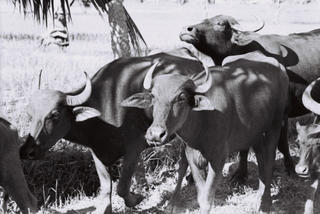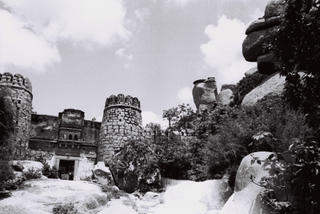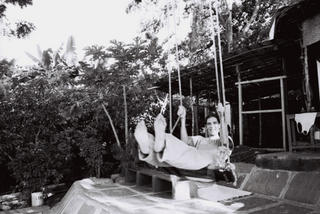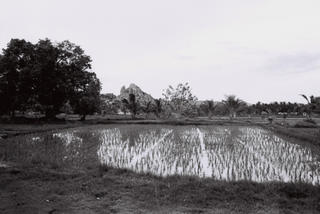God's Own Country
 So, apparently I haven't posted in a while...though to me it seems like we just got back from Kerala. We've been saying goodbye to a lot of friends since then. Anne-Julie, the Institute French teacher, went back to Paris last week. Her replacement, Cécile, seems to be enjoying the job so far. Ivan is still here but his parents are visiting, so we haven't seen him much, and he'll be heading to China and then back to Switzerland soon. Valérie and Michel went back to France, but they were only here three weeks, so it's not really the same kind of farewell. Finally Charline is leaving tonight - we just had a farewell lunch for her at our favorite local Continetal restaurant, Baron's Court.
So, apparently I haven't posted in a while...though to me it seems like we just got back from Kerala. We've been saying goodbye to a lot of friends since then. Anne-Julie, the Institute French teacher, went back to Paris last week. Her replacement, Cécile, seems to be enjoying the job so far. Ivan is still here but his parents are visiting, so we haven't seen him much, and he'll be heading to China and then back to Switzerland soon. Valérie and Michel went back to France, but they were only here three weeks, so it's not really the same kind of farewell. Finally Charline is leaving tonight - we just had a farewell lunch for her at our favorite local Continetal restaurant, Baron's Court.
Just last week we were at the engagement ceremony of Charline and her Indian fiancé, Prince. They are both in the same field as Gilles, so he knew them both from France. (Prince spent 8 months working in Paris, and Charline has been to India twice as well). The ceremony was interesting - it took place in an old Catholic church in the suburbs of Ernakulam, which is the big city part of Kochi. We stood up, there was no singing, and we had to take off our shoes, so it didn't seem much like a Catholic ceremony. Afterwards we went to Prince's house and ate tons of Malayali dishes, including a lot of beef. Apparently the Keralites eat beef often - at least the Christians, which make up a large part of the population there. They say that Christianity dates back to just after the year zero, when St. Thomas came to India, but no one can really verify that story. The early Christians were essentially Orthodox, but many became Catholic after the arrival of the Portuguese. Anyway, Prince's family is part of that second group, so Charline converted to their religion (Catholicism). Previously she had belonged to the official religion of France (atheism).
Before we went to the engagement we visited Fort Cochin, which is a very nice part of Kochi. It has a real small-town feel, with a lot of old churches and schools and very few vehicles. The churches themselves were not terribly fascinating, but we enjoyed walking around and eating fish. My favorite part was the old Synagogue, which was the focal point of the Cochin Jewish community, which now seems to number about ten. They also have a story that might be based in myth - that they arrived after the destruction of the temple in 70 AD in boats. The synagogue is not quite so old (I think it was 17th century) and its floor is covered in blue and white Chinese tiles - it looks kind of like it belongs in China, and kind of like it belongs in Delft. We also had to take off our shoes to walk into the synagogue. Supposedly the population of Jews has decreased to nearly zero because of the creation of Israel, but they also may have simply not found enough other Jews to marry. I guess it's easy to disappear in India if your community is not as big as the others. 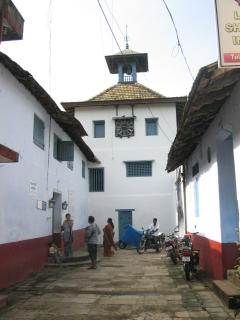
While we were in Kerala, we also visited the Periyar National Park, which is on the border with Tamil Nadu, up in the hills. We signed up for a trek, which involved walking through the woods for three hours with a very small man who smoked a lot. Actually, before we could walk in the woods we had to check out leech-proof socks and board a not-very-seaworthy bamboo raft that took us from the ranger station to the trekking area. The leech socks came in handy after just a few minutes, when we realized that every time we stopped our shoes and pants were covered in leeches. We poured tobacco powder over our shoes, and that seemed to deter the leeches, though when we finished the trek both Gilles and I found leeches on the tongues of our shoes. No harm done, anyway. The ranger just casually knocked them off his arms when they landed on him.
We didn't see too much in the way of wildlife - a giant squirrel, some nice birds, a sambar deer. We heard some angry elephants in the distance and tried to track them, but the ranger said it could be dangerous to annoy them further so we couldn't get too close. We didn't really like the idea of being trampled by a herd of elephants. After our trek we took a very educational tour of a spice garden - it was interesting to see the plants our spices come from. The highlight of our trip to Kerala, which they call God's own country, was cruising down the beautiful backwaters. We didn't see much and we didn't go very far, but the environment was beautiful and our boat was none too shabby. I think Kerala is still my favorite part of India - it just seems more laid-back, and the lush vegetation makes it much more pleasant than Bangalore. We also noticed that Keralites seem to sing all the time - on buses, on ferries, on the little bamboo raft. They seem pretty happy to live in Kerala, really. Heck, if God lives there it makes sense...
The highlight of our trip to Kerala, which they call God's own country, was cruising down the beautiful backwaters. We didn't see much and we didn't go very far, but the environment was beautiful and our boat was none too shabby. I think Kerala is still my favorite part of India - it just seems more laid-back, and the lush vegetation makes it much more pleasant than Bangalore. We also noticed that Keralites seem to sing all the time - on buses, on ferries, on the little bamboo raft. They seem pretty happy to live in Kerala, really. Heck, if God lives there it makes sense...




